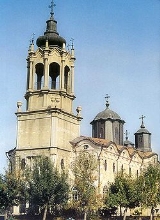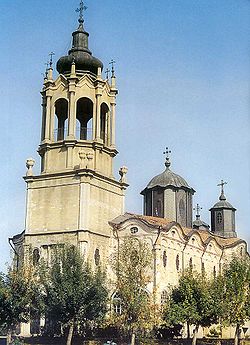
Church of the Holy Trinity, Svishtov
Encyclopedia

Bulgarian Orthodox Church
The Bulgarian Orthodox Church - Bulgarian Patriarchate is an autocephalous Eastern Orthodox Church with some 6.5 million members in the Republic of Bulgaria and between 1.5 and 2.0 million members in a number of European countries, the Americas and Australia...
church in the northern Bulgaria
Bulgaria
Bulgaria , officially the Republic of Bulgaria , is a parliamentary democracy within a unitary constitutional republic in Southeast Europe. The country borders Romania to the north, Serbia and Macedonia to the west, Greece and Turkey to the south, as well as the Black Sea to the east...
n town of Svishtov
Svishtov
Svishtov is a town in northern Bulgaria, located in Veliko Tarnovo Province on the right bank of the Danube river opposite the Romanian town of Zimnicea. It is the administrative centre of the homonymous Svishtov Municipality...
and one of the finest examples of late Bulgarian National Revival
Bulgarian National Revival
The Bulgarian National Revival , sometimes called the Bulgarian Renaissance, was a period of socio-economic development and national integration among Bulgarian people under Ottoman rule...
church architecture.
A work of the best-known Bulgarian architect of the period, Nikola Fichev, the church was inaugurated on 19 September 1867 and constructed on the highest spot in the town. The three-nave
Nave
In Romanesque and Gothic Christian abbey, cathedral basilica and church architecture, the nave is the central approach to the high altar, the main body of the church. "Nave" was probably suggested by the keel shape of its vaulting...
d church features a central dome and an elongated 30 m-long body with thin and high columns supporting the naves, as well as three smaller domes. The design of the façade
Facade
A facade or façade is generally one exterior side of a building, usually, but not always, the front. The word comes from the French language, literally meaning "frontage" or "face"....
s is particularly remarkable. Fichev notably broke the Orthodox architectural canon by making the whole east façade a giant undulating apse
Apse
In architecture, the apse is a semicircular recess covered with a hemispherical vault or semi-dome...
.
The iconostasis
Iconostasis
In Eastern Christianity an iconostasis is a wall of icons and religious paintings, separating the nave from the sanctuary in a church. Iconostasis also refers to a portable icon stand that can be placed anywhere within a church...
, 16 m long and an average 10 m high, was created by Anton Peshev from Debar
Debar
Debar is a city in the western part of the Republic of Macedonia, near the border with Albania, on the road from Struga to Gostivar. It is the seat of Debar Municipality.-Geography:...
in 1870–1872 and the 73 icons were painted by Nikolay Pavlovich, a master from Svishtov. The bell tower
Bell tower
A bell tower is a tower which contains one or more bells, or which is designed to hold bells, even if it has none. In the European tradition, such a tower most commonly serves as part of a church and contains church bells. When attached to a city hall or other civic building, especially in...
, stylistically a reference to Baroque architecture
Baroque architecture
Baroque architecture is a term used to describe the building style of the Baroque era, begun in late sixteenth century Italy, that took the Roman vocabulary of Renaissance architecture and used it in a new rhetorical and theatrical fashion, often to express the triumph of the Catholic Church and...
, was added in 1883–1886 and designed by Gencho Novakov.
Several important figures, including the first Bulgarian Exarch
Bulgarian Exarchate
The Bulgarian Exarchate was the official name of the Bulgarian Orthodox Church before its autocephaly was recognized by the Ecumenical See in 1945 and the Bulgarian Patriarchate was restored in 1953....
Antim I
Antim I
Antim I , born Atanas Mihaylov Chalakov , was a Bulgarian education figure and clergyman, and a participant in the Bulgarian liberation and church-independence movement. He was the first head of the Bulgarian Exarchate, a post he held from 1872 to 1877...
(1872), the Metropolitan of Tarnovo Ilarion Makariopolski
Ilarion Makariopolski
Ilarion Makariopolski , born Stoyan Stoyanov Mihaylovski was a 19th-century Bulgarian cleric and one of the leaders of the struggle for an autonomous Bulgarian church....
(1872) and the eparchial metropolitan bishop Clement of Tarnovo
Kliment Turnovski
Kliment Turnovski, , was a leading Bulgarian clergyman and politician...
(1889) have held services in the church. It was also visited by Russian Emperor
Tsar
Tsar is a title used to designate certain European Slavic monarchs or supreme rulers. As a system of government in the Tsardom of Russia and Russian Empire, it is known as Tsarist autocracy, or Tsarism...
Alexander II
Alexander II of Russia
Alexander II , also known as Alexander the Liberator was the Emperor of the Russian Empire from 3 March 1855 until his assassination in 1881...
, who attended the service on 28 June 1877. Alexander II also donated six bells for the bell tower.
The Church of the Holy Trinity suffered damage from an earthquake
1977 Bucharest Earthquake
The 1977 Vrancea Earthquake occurred on Friday, 4 March 1977, 21:20 local time and was felt throughout the Balkans. It had a magnitude of 7.2 with an epicenter in Vrancea at a depth of ....
on 4 March 1977, but was subsequently restored. Today, the church with its iconostasis is a cultural monument of national importance.

